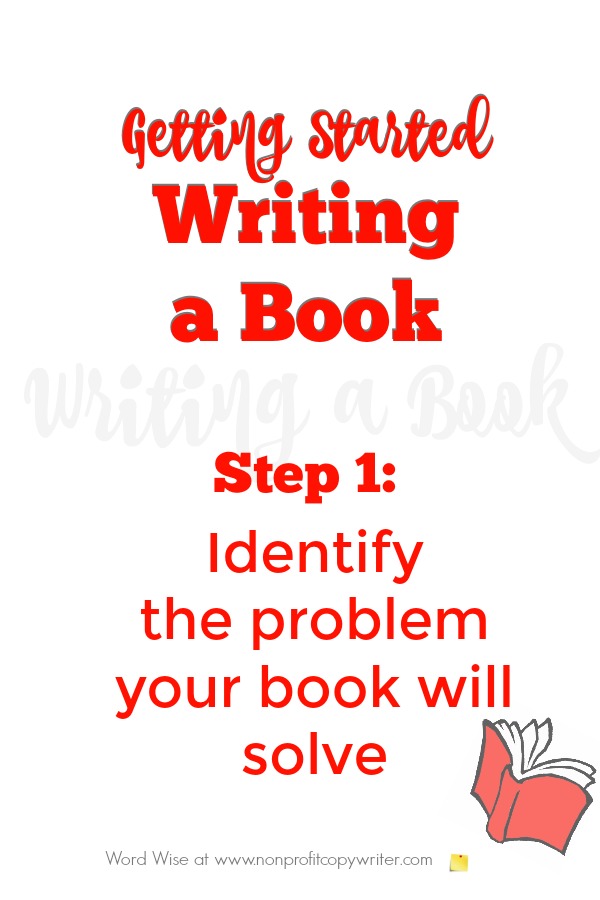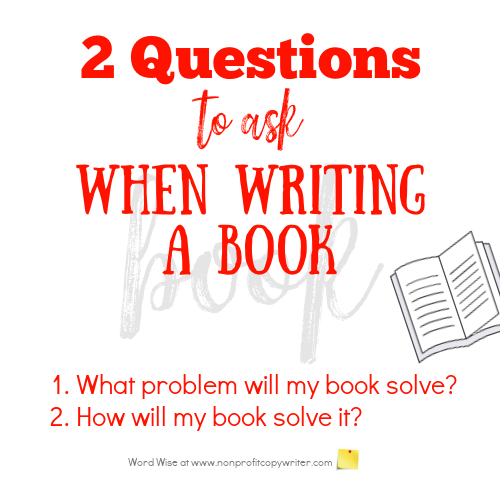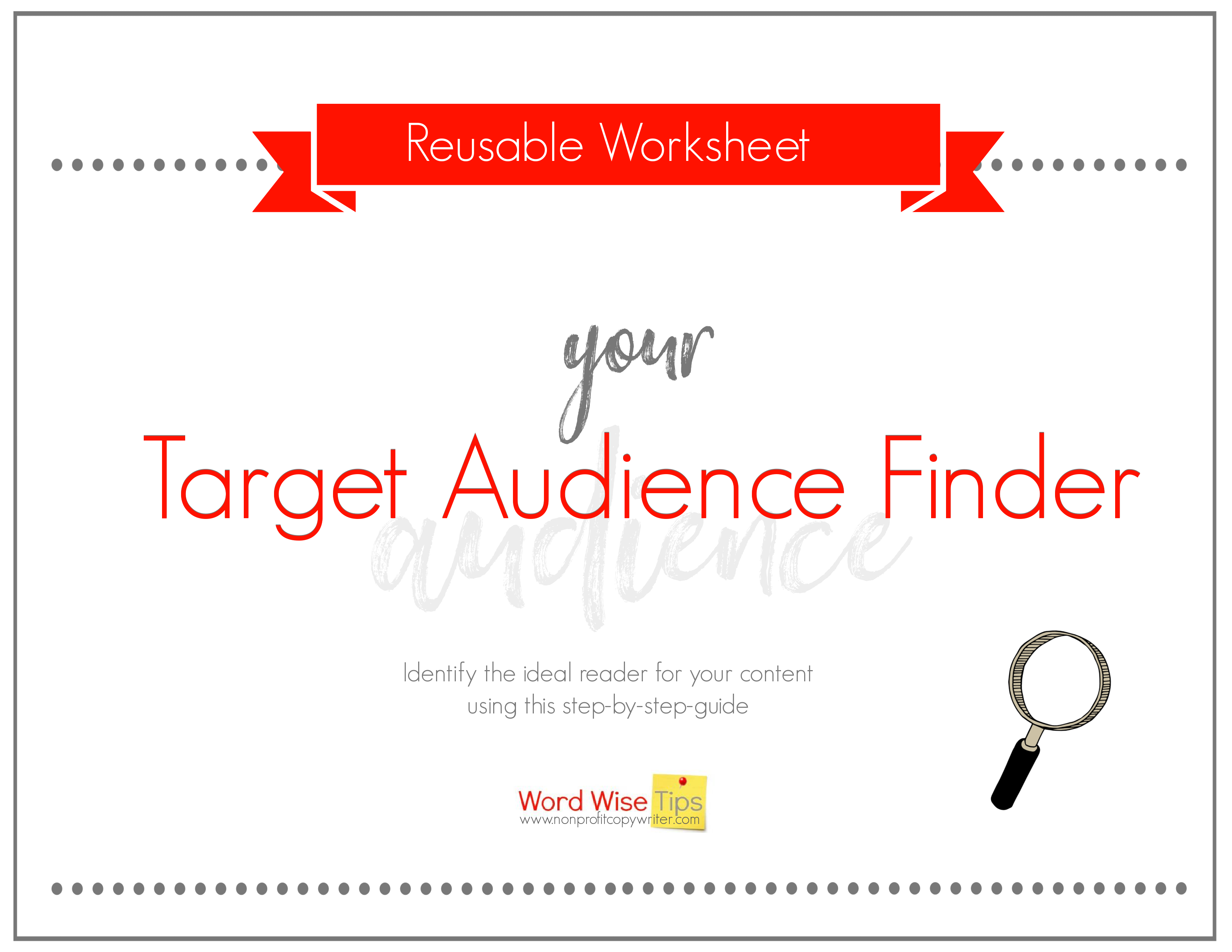Save Time: Get 5 Simple Writing Tips
you can put to use in 10 minutes
Book Writing Help Step 1
Identify the Problem Your Book Will Solve
Award-winning writer Kathy Widenhouse has helped hundreds of nonprofits and writers produce successful content , with 750K+ views for her writing tutorials. She is the author of 9 books. See more of Kathy’s content here.
Updated 10.1.24
“I need book writing help!”
I hear that all the time. Writing a book can seem overwhelming. Where should you begin? What should you do first?
Here’s the truth: a book is just a series of small bits of writing, strung together. To write a book, simply break down the whole into smaller parts. Then complete each small part, one at a time.
When you break the process into smaller steps, writing a book can be a reality. One step is manageable. Do a few steps and soon, you’ll be on your way.
Book writing help step 1: Identify the problem your book will solve
A good nonfiction book addresses a problem and explains a way to solve it.
- You may have a general topic concept.
- You may have no topic idea and you simply want to write a book.
- You may have a fair idea about what your book will be about.
- You may have been gathering information for a long time.
- You may be anywhere in any of those stages.
But no matter where you are in the concepting process right now, do not write one word of your masterpiece until you’ve taken one crucial step. You need to identify the problem your book will solve – and how your book provides a solution.
Why should you identify the problem FIRST?
- So you can write purposefully. Identifying the problem your book addresses gives clarity as you write. When you’ve got a challenge recorded in black and white – and a successful solution – you’ve got a ready-made central theme for your book. That message guides your writing and ensures that every chapter and paragraph contributes to solving that problem. Let’s say you love to knit baby blankets for family and friends as they have children. Countless baby shower guests stare at your creations in wonder, claiming, “I’ve always wanted to learn to knit.” You’ve identified a problem: beginners want simple steps they can follow to learn to knit and easy baby blanket patterns to use in the process.
- So you can identify your target audience. When you understand who your readers will be, you know who is most likely to benefit from your book and can tailor your content to meet their specific needs and challenges. In the case of our example, your target readers are people who have never knit before but want to.
- So you can market your book. A clearly defined problem and target audience make your book easier to pitch to publishers, agents, and readers. You can articulate the unique value your book offers for a specific group.
- So you can engage readers. Books that solve specific problems resonate with readers who face that problem. They are more likely to engage with your content, apply your advice, and recommend your book to others facing similar challenges.
Think back to our knitting example. Your readers are eager to find ways to occupy their hands during long evenings in front of the television. And now, with your book, they can not only knit – but also produce beautiful blankets for babies as they come into the world.
How to identify the problem your book will solve
To get started writing your book, ask yourself two questions:
- What problem will your book solve?
- How will your book solve it?
Your answers to these two questions drill down the topic of your book. This is a crucial step – but one that many would-be authors overlook.
Is it any wonder that so many books fail to get traction? The author hasn’t taken the time to spell out a problem and explain how the book offers answers. The Problem-and-Solution formula is the foundation forms the foundation upon which your entire book will be built.
Once you are able to articulate the problem your book will solve and the solution, you will be on your way to writing your book.
Choose a problem
Choose a problem that interests you.
If you know you want to write a book but you don’t know exactly what you want to write about, start with a topic that captures your attention. You’ll be spending a great deal of time understanding this problem and writing about how to solve it. Make sure you are interested in it.
Choose a problem with which you have experience.
It could be personal know-how or information you have acquired (or are eager to acquire during the writing process.) Experience allows you to write with the voice of authenticity and authority. You may not think of yourself as an expert knitter. But you’ve been knitting for 20 years. Guess what? You can come alongside newcomers with plenty of tips and know-how.
Choose a problem with a solution.
Ask yourself if the topic presents helpful information. If you write a book that presents a problem but offers no solution, readers won’t find value in it – and won’t buy it. Does your problem and solution have potential to positively affect people’s lives? Is it entertaining or humorous? Will the content answer questions or impart a deeper understanding about people or the world? Will it address a topic that is relevant? Does the book tell a story that has yet to be told? Will it offer simple how to’s? All of those solutions are useful to potential readers.
Choose a problem with a solution that you believe in.
Your name will be on this book for a long time. Make sure your investments of time, energy, and expertise are well placed.
Use this DIY worksheet to identify the target audience for your book.
How will your book solve this problem?
By now you have a general idea of a problem your book will solve. Now go deeper.
- Research your audience. Write down a description of your target reader. Understand their demographics, interests, pain points, and goals. Use surveys, interviews, and social media engagement to get additional insights.
- Identify your readers’ challenges. Based on your audience research, identify the most common challenges you readers face – and how those challenges align with the problem you have identified. Look for recurring themes or issues that many of your target readers struggle with.
- Define the core problem. From the list of challenges, narrow down to one core problem that your book will address. This problem should be significant enough to capture your audience's attention and resonate with their needs.
- Craft your unique solution. You’ve identified a core problem. It’s one with which you have experience. Now develop your own solution or approach that sets your book apart. This could be a new perspective, a step-by-step method, or actionable strategies that readers can put in to practice. Your book addresses provides answers, information, solutions, clarification, or how-tos to address that challenge. In the case of teaching beginners to knit, you have a special approach: you want to teach newcomers by giving them a simple project they can complete as they learn basic knitting patterns. Not only will they learn to knit, but they can have a sense of accomplishment in the process.
- Validate your book concept. Before diving into writing, check with friends, colleagues, beta readers, or even industry experts to make sure your book idea is compelling. Use their feedback to refine your idea so it resonates in your niche. If you’re writing a knitting book for beginners, you could conduct a simple survey within your Facebook knitting groups. Ask them if such a book would have been helpful for them when they started knitting. Find out if any of their friends want to learn to knit and what they think of the group. Ask experienced knitters what to include in a beginner’s knitting book – and what not to include.
Book writing help step 1
Get started writing your book by filling in the two blanks.
My book explains [problem: ] to readers
so they can [solution: ].
More about Writing a Book
Getting started writing a book ...
How to Use a Personalized Book Writing Plan to Get Your Book Done ...
5 Places to Find Book Ideas ...
Test Your Book Idea with These 4 Questions ...
How To Get Started Writing a Book With a Brain Dump ...
Tips on Writing a Book (Before You Get Started Writing) ...
E-Books Versus Print Books: Which Do Readers Prefer?
How to Write a Book Summary that Sells Your Book ...
Top Tip for Selling Your Book ...
Book Writing Help Step 2: Identify your readers ...
Book Writing Help Step 3: Find your book's unique niche ...
Book Writing Help Step 4: Write a Summary Sentence ...
Book Writing Help Step 5: Choose a Publishing Platform ...
Book Writing Help Step 6: Write a Book Outline and Chapter Plan ...
Book Writing Help Step 7: Create a Writing Plan ...
6 Tips for Writing Good Copy for Your Book Jacket ...
How to Get Book Reviews For Free ...
Writing eBooks: Frequently Asked Questions ...
More inspiration from our Writing a Book Pinterest board...
Return from Book Writing Help, Step 1 to Nonprofit Copywriter home
As an Amazon Associate I earn from qualifying purchases.
Share This Page

Named to 2022 Writer's Digest list
BEST GENRE/NICHE WRITING WEBSITE


Stop Wasting Time!
Grab your exclusive FREE guide, "5 Simple Writing Tips You Can Put to Use in 10 Minutes or Less"














